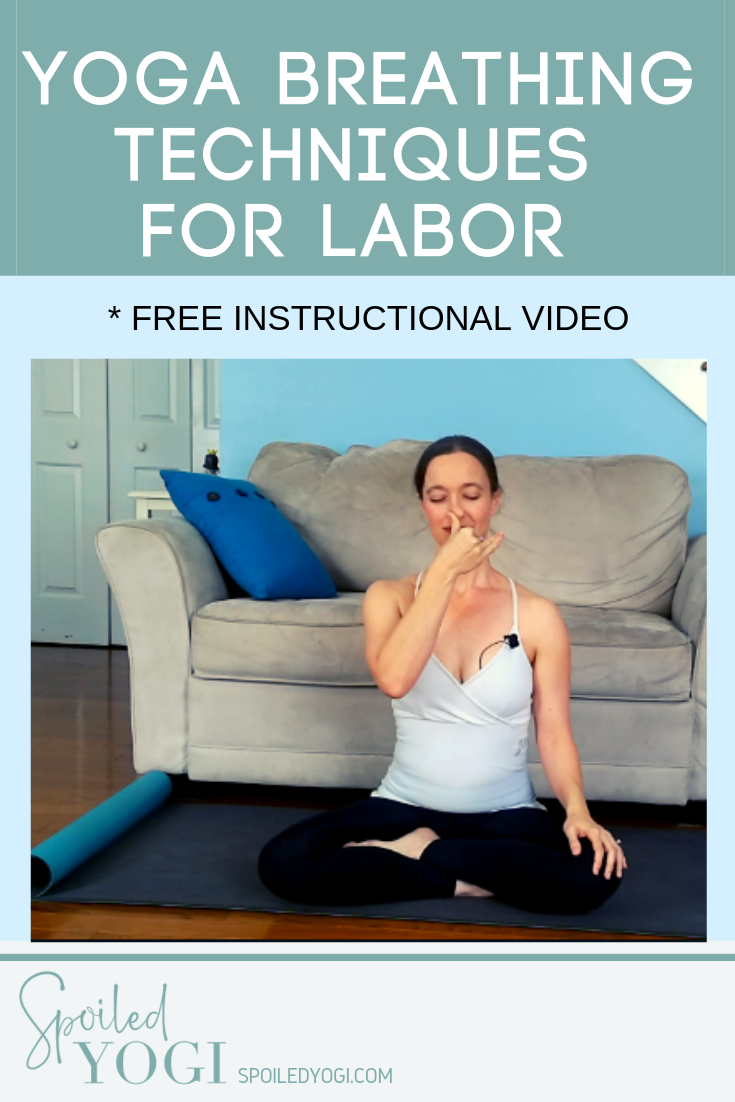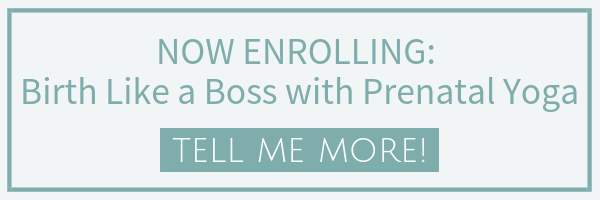
You can write birth plans until you’re blue in the face. You can hire the best medical professionals and support team. You can spend time making sure your partner knows all the best massage techniques to help you during labor. You can read all the pregnancy and birth books. You can practice the best positions (And all of those things are great things to do during pregnancy to prepare for your birth!)
But the bottom line is this: At some point in labor (particularly non-medicated, natural labor), most mamas have the most success with managing labor pains by focusing on breathing techniques for labor and childbirth.
The pregnant women I’ve worked with in my prenatal yoga classes and workshops have reported that working on specific breathing techniques for labor helped them more than anything else during those most challenging moments of their births.
Why Breathing Is Important During Labor and Birth
I have a theory about why so many mamas rely on their breathing techniques during labor and birth. As labor progresses, moms-to-be tend to “get into the zone” and it’s hard for them to concentrate on anything other than the intense sensations they feel in their bodies.
It’s really hard to describe what this is like if you’ve never experienced it, so I’ll give an example:
I have a friend who recently had a baby. Toward the most intense part of her labor, she thought she was communicating with her husband that she wanted to get an epidural. She said it over and over again, but it seemed like no one heard her. Later, after the baby was born (epidural free) she asked her husband about it. He hadn’t heard her say anything at all–just moans and groans!
When you’re so consumed by the birthing process that it becomes hard to communicate it can be near impossible to remember all. the. things. you know you could do to help you stay calm, grounded, and relaxed. So mamas rely on the coping techniques that have become second nature to them.
For those women who practiced prenatal yoga, that’s usually their breath!
It makes sense. For weeks and months before the big day, they put their bodies into uncomfortable positions that came with some intense sensations… and they stayed there.. and they breathed.
They saw that they were stronger than they knew. They felt the discomfort come and go as they focused on their breath. They also might have noticed that because of the intrinsic connection between body, mind, and breath, that deep, focused breathing both relaxed their bodies and minds and shifted their nervous systems into a more calm state.
During that time when they were learning yoga postures and mindfulness, they were also learning invaluable tools that would help them give birth. #WINNING
How amazing is that?

Of course, you don’t have to practice prenatal yoga to get benefits from yoga breathing techniques, also called pranayama. The following types of conscious breathing techniques for labor can help soothe a tired mama who’s about to give birth, but they are also amazing for moms AFTER the birth when they’re sleep-deprived and adjusting for life with a new baby.
Heck, they’re good for ANYONE who ever gets stressed or overwhelmed ANYTIME! So if that’s you (and really doesn’t that describe everyone?) keep reading. You’ll be glad you did.
(NOTE: Sitting up tall may or may not be possible during labor! All of these breath techniques for labor can be practiced in any position that feels most comfortable for a laboring mom!)
6 Yoga Breathing Techniques for Labor (Or Any Stressful Situation Where You Need to Calm Down!)
Breathing for Two
This is my favorite breathing technique for pregnancy because it not only helps mamas to get their breath to go all the way down into their bellies, but it also helps them bond with baby.
During labor, this is a lovely reminder of why they’re doing this in the first place. It’s for that baby growing within. The baby you’ve already grown to love in pregnancy. It’s the baby you’re finally going to gaze upon and hold in your arms. Every contraction is bringing that reality closer. Every breath delivers a bit more oxygen, nourishment, and love to your little one.
Here’s how to do it:
Sit up tall. Bring one hand to your heart and rest the other hand on your baby. Close your eyes. Soften your jaw, lips, and tongue. Take a moment to just notice what your breath is doing, without trying to change it. Notice the quality of the breath. Does it feel easy or labored.
(Ha! Sorry, bad joke.)
Where does your inhale go? First, just notice. Then, slowly, start to deepen the breath. Notice as the breath goes past your throat, fills up your collarbones, expands your rib cage, and finally touches that little baby growing within.
Stay with it for as long as you can, visualizing your baby getting more love from you with each inhale. Exhale, letting go of tension, anxiety, and any other feelings that aren’t serving the birth of your beautiful babe.
Ocean Breath
For me, there is no other kind of breath that is more soothing. This could be because the sound of the ocean is soothing, anyway. I think since this is the breath I often practice as I move through my asana practice, there’s also an association of the calm I feel then.
This is the breath I turn to most often when I need to ground or calm myself. I do it when I’m anxious, when I need to focus, and also when I need more a boost of energy.
Here’s how to do it:
Take a big breath in through your nose. As you exhale, part your lips and breathe the way you’d breathe as if you were fogging up a mirror. Haaaaa. Keep that mirror-fogging quality to your breath, but close your mouth. You’ll likely feel the breath like a whisper in the back of your throat. It’s audible to you and maybe if someone were standing very close to you, they could hear it, too. It’s easiest to access on the exhale, but after a while you’ll be able to make the noise on the inhale, too.
As you breathe, imagine ocean waves lapping up on a shore, maybe even washing over you bringing calm and taking away any tensions, anxieties, and anything else that is not serving you in the moment.
Balanced Breath
This breathing technique is exactly what it sounds like. It can help to bring more balance in the mind and the body. It’s great for those times when all you really want is practice mindfulness and focus without having to think too much about it (or force anything).
Here’s how to do it:
Close your eyes. Sit up tall. Lift the crown of your head up toward the ceiling. Take a big breath in through your nose, and, with an exhale, feel your shoulders drop down toward the floor. For a few breaths, don’t try to change anything: Just pay attention to the natural rhythm of the breath.
Then, start to count to yourself how long each inhale and exhale lasts. Maybe you’re inhaling for 5 seconds and exhaling for 4, for example. Be very gentle with yourself as you gradually, over the course of several breaths, start to lengthen out the part of the breath that is shorter until you are breathing in and out for the same amount of time. Continue for a few minutes, then open your eyes and return to your normal breath.
Long Exhale
Whenever you feel yourself going into a fight-or-flight mentality (that’s when the stress response takes over), a good way to calm the nervous system is to elongate the exhale.
Here’s how to do it:
For a few breaths, don’t try to change anything. Just pay attention to the natural rhythm of the breath. Then, begin to count how long your inhales and exhales last. Maybe you inhale for 4 and exhale for 5. Over the next few breaths gradually start to lengthen your exhale until it’s twice as long as your inhale–something like breath in for 5 and out for 10.
Continue for a few minutes, then open your eyes and return to your normal breath hopefully feeling more calm and centered.
Left-Nostril Breathing
Left nostril breathing is another way to shift the nervous system into a more calm state. (In Kundalini Yoga, the right side is said to be the masculine side associated with a fast-pace response during times of stress. The left side is the feminine side, which is calmer, slower, and more relaxed.)
This is a great breath to do during the earlier stages of labor or between contractions to help you stay calm and relaxed.
Here’s how to do it:
Sit up tall, close your eyes, and notice your breath coming in and out through your nostrils. With your next exhale empty all the air from your lungs. Bring your right thumb to your right nostril to block the air (let all the rest of your fingers point straight up). Block the right nostril as you breathe in through the left as slowly and smoothly as you can. Pause for just a beat at the top of the inhale. Then breathe slowly and smoothly back out through that left nostril.
Continue for a few minutes, then bring your right hand back to your lap. Breathe through both nostrils for a couple of breaths before you open your eyes and begin to breathe normally.
Alternate Nostril Breathing
Here’s a fun fact. When Hilary Clinton was on the campaign trail running for president in 2016, she dealt with her anxiety by practicing alternate nostril breathing. No matter how you feel about Hilary, you’ve got to admit that if it worked to calm her during that high-stress situation, it’s got to be a powerful breathing technique. And it can work when stress and anxiety are high in the time leading up to childbirth, too.
It’s a lot like Left-Nostril Breathing, but tends to be a more balanced and grounding breath. It is my go-to when I’m starting to feel stressed out or anxious. I’d choose left-nostril breathing (above) when I really need to calm down.
Here’s how to do it:
Sit up tall and start to pay attention to your breath. Notice how it flows in and out naturally. Then, with your right hand, curl your index and middle finger in, but hold your thumb, ring, and pinkie fingers out. (Hold your ring and pinkie fingers together so they look like one unit.)
Exhale everything out. Then plug your right nostril with your thumb, breathe in slowly through the left nostril. Keep the right nostril closed as you breathe back out through the left nostril. When you’re done exhaling, switch and close off the left nostril using your ring finger. Breathe in slowly and back out of the right nostril. Continue for a few minutes, and try to finish with an exhale out the right nostril (so you’ve done both sides evenly).
When you’re done rest both hands on your lap and breathing normally for a few rounds. Then, blink your eyes open and notice how you feel.


Comments